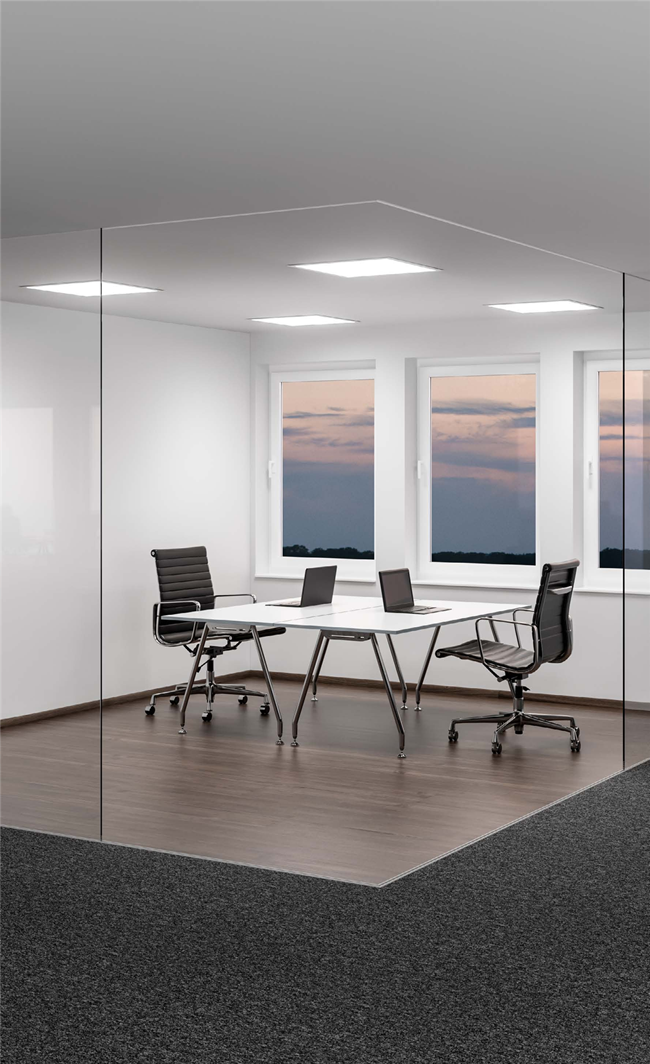The Biological Effects of Lighting
Employers are increasingly realizing that people are their greatest asset, not just their highest cost.
To attract and retain talent, employees’ health and wellbeing is a high priority because they know flourishing employees are what drive a thriving business. As 90% of business costs are staff related, investing in comfort can be one of the fastest ways to boost efficiency.
So, it’s not surprising that many organizations are keen to enhance workplace comfort and use health and wellbeing building certifications as guidance and proof points.


What is Human-centric Lighting?
Lighting has a profound effect on people. The reason is simple; light is the most powerful regulator of our circadian rhythm. Light has visual, biological, and emotional benefits. This is paramount for human-centric lighting for people’s health and wellbeing. Investing in human-centric lighting makes perfect business sense because healthy and engaged employees make a positive contribution to productivity. In fact, leading employee experience firm DecisionWise found that disengaged employees cost organizations an average of $3,400 a year for every $10,000 in annual salary. Those who are committed to an organization, emotionally as well as mentally, are likely to perform best at work and will miss 20% fewer work days.
At DECENTEK, we have a deep understanding of the effects that light can have on people, coupled with the technological know-how to deliver quality solutions that enhance visual comfort, wellbeing and performance. As human-centric lighting applications gather momentum, we have the expertise to deliver a wide range of high-quality lighting solutions that building occupants, facility managers and installers can use to create more inclusive and satisfying workspaces. Light has a visual impact (see better), an emotional impact (feel better) and a biological impact (function better).
Light to See Better
A good lighting design supports the illumination of objects in the central vision, with balanced lighting in the peripheral vision to provide optimal eye comfort. Light that supports people to see better creates exactly the right balance between clarity and comfort, while taking into account the specific user needs in the environment. One challenge that is present in society today, and implicitly in workplaces is aging. The eye already starts to deteriorate around age 45, which means that approximately one third of the potential working population is already facing reduced vision. Research conducted by DECENTEK confirms this situation and found that visual acuity and perceived comfort can be improved by increasing light levels. This is relevant since visual fatigue and discomfort have been reported to relate to ergonomic complaints such as pain in neck and shoulder. Other research indicates that users across age groups tend to prefer higher light levels for more demanding tasks, while lower levels are often experienced as more relaxing for the eyes. The right light depends on the task at hand, but it is clear that a conducive working environment, and comfortable vision, relies on well-balanced lighting design for spaces.
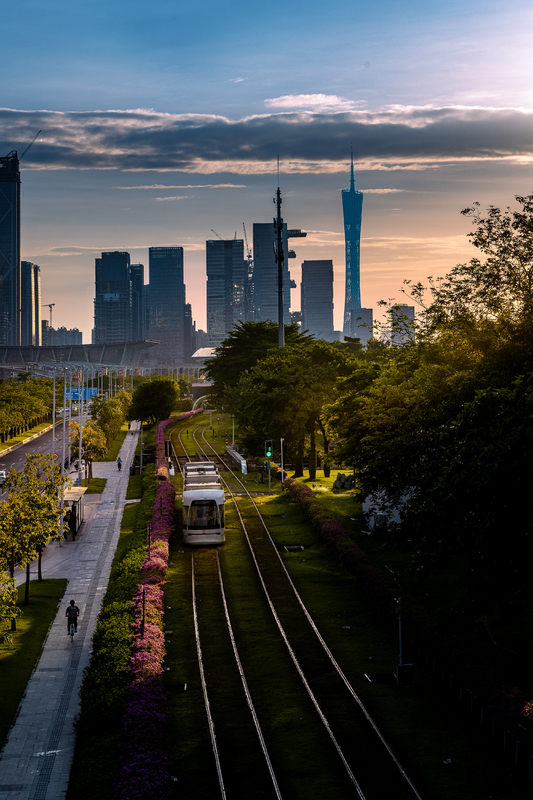
Light to Feel Better
Another crucial element is the emotional benefit of natural light to make people feel better. Positive effects of light on behavior, mood, satisfaction, and comfort have been intensively studied in the past years. The concept of Biophilia, the practice of incorporating nature and natural elements into the built environment, is an especially strong contributor to this. Biophilic Design has been proven to measurably reduce stress, enhance cognitive function and creativity, boost productivity and increase wellbeing. Specifically, access to natural light and views of the outdoors has been identified as the number one valued attribute of the workplace environment. In offices with natural elements, such as plants and sunlight, a 15% higher level of wellbeing, 6% higher level of productivity, and 15% higher level of creativity have been reported. Other research shows that bright light exposure, via artificial skylights, generates psychological comfort, increased productivity, and assumed health. Since the natural light benefits of seeing better, functioning better and feeling better are interdependent, efforts to influence one will always relate to influencing the other two. As a consequence, designing spaces must balance these three elements, with the aim of satisfying the needs and desires of the people using the space, while addressing the regulations and requirements for the space.
Light to Function Better
Light also enables people to function better. To be active during the day and rest well at night, our body needs a stable predictive cycle that is synchronized to the natural day rhythm. Preferably in the morning, people need a boost in energy and focus, to function effectively during the day. Morning light plays a significant role in triggering this energy boost, and bright light during the day enhances circadian rhythm, regulating the sleep-wake cycle. Traditional workplace design focusses on providing light that is good for vision and in line with the norms in indoor spaces: 300-500 lx. However, natural daylight levels are much higher than these levels, ranging from 10,000-100,000 lx. Exposure to higher indoor illuminance levels of at least 1,000 lx, has been proven to increase alertness and performance.
Besides light quantity expressed in intensity, the light quality expressed in spectral distribution plays an important role for people’s health and wellbeing. Specifically, light enriched in the 450-530 nm range is proven to be an effective and powerful light signal to regulate the timing, robustness and rhythmicity of the body clock, thus directly impacting the ability to stay alert and focused (for work or learning) during the day or to fall (or remain) asleep at night.
Light Nutrition and the Sleep-wake Cycle
To be active during the day and sleep well at night, our body needs a stable predictive cycle that tells it when to expect darkness or light. It’s the suprachiasmatic nucleus (SCN) which is responsible for controlling circadian rhythms. This is a tiny region of the brain in the hypothalamus.
But for most people, this central pacemaker in the brain is likely to have a clock that’s longer than 24 hours. That means if it’s not entrained to the external light/dark cycle, it will rapidly start to run out of sync - even if the periods of light remained constant. Furthermore, synchronizing the SCN and other clocks in the body takes time. That’s why we don’t adapt instantly to changes in the light-dark cycle, and explains why we experience jetlag. A weak and/or irregular circadian rhythm is a risk to people’s health: it can lead to poor sleep, depression, weight gain and even cancer. Sleep deficiency is associated with an increased risk of obesity, diabetes, cardiovascular disease and depression.

The Biological Clock and Circadian Rhythms
Almost all cells in the human body need input from the outside world to synchronize with the daily light/ dark cycle. The central pacemaker, which is located in the SCN, just behind the eyes, plays a key role. The SCN has around 20,000 neurons divided into a light-sensitive part and a non-light sensitive part. The non-light sensitive part drives our internal circadian rhythms without any external input, telling the body when to expect darkness or light. In contrast, the light-sensitive part, which receives input from the eyes, adjusts our internal clock to changing external circumstances, such as when the length of daytime changes with the seasons. Levels of melatonin and the core body temperature trigger signals from the SCN to the rest of the body to give it an estimate of the external light/dark cycle. These signals drive a whole range of other processes in the body with 24-hour rhythms, such as heart rate, blood pressure and the release of hormones like cortisol and insulin - all of which have a strong influence on the sleep/wake cycle. There are many more biological processess that are influenced by ipRGC photoreception. Scientists discovered for instance direct pathways to the mood and learning centers in the brain.
Light enables us to see the world around us. Traditionally, indoor lighting was mainly driven by visual requirements. It is only relatively recently that a novel photoreceptor type in the inner retina was discovered, fundamentally challenging this traditional view. It is now known that, in addition to stimulating the visual system, light incident on the retina stimulates other biological functions - also referred to as non-visual responses. Light regulates our day and night rhythm and helps us to function better. In addition, light creates atmosphere and sets our mood, it evokes specific emotions and helps us to feel better.
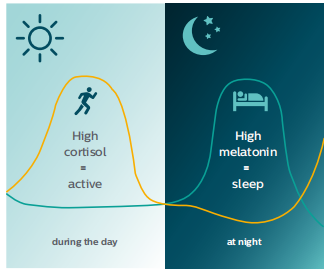
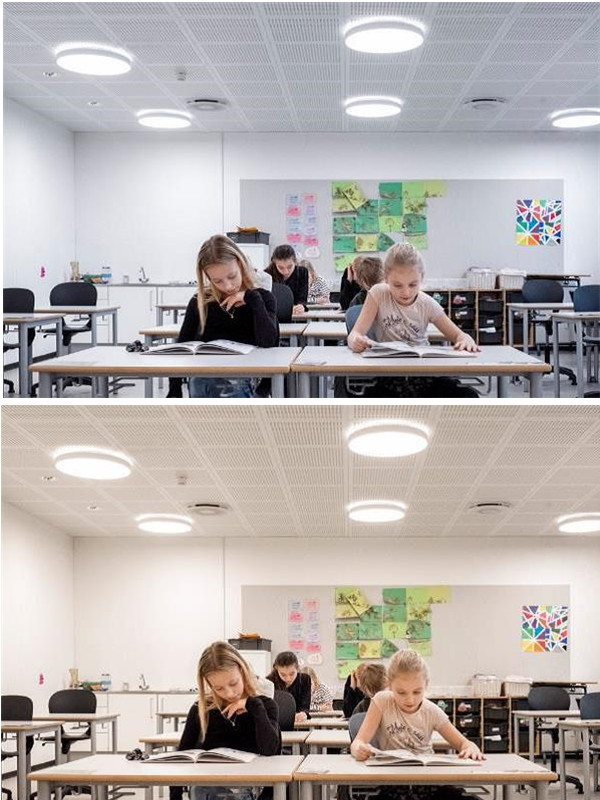
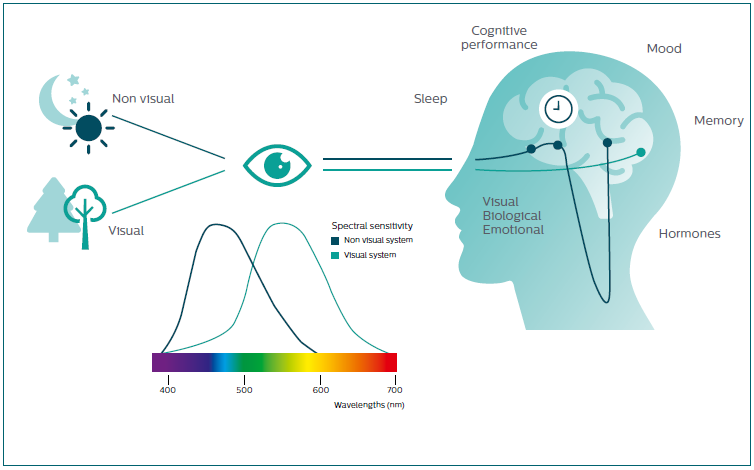
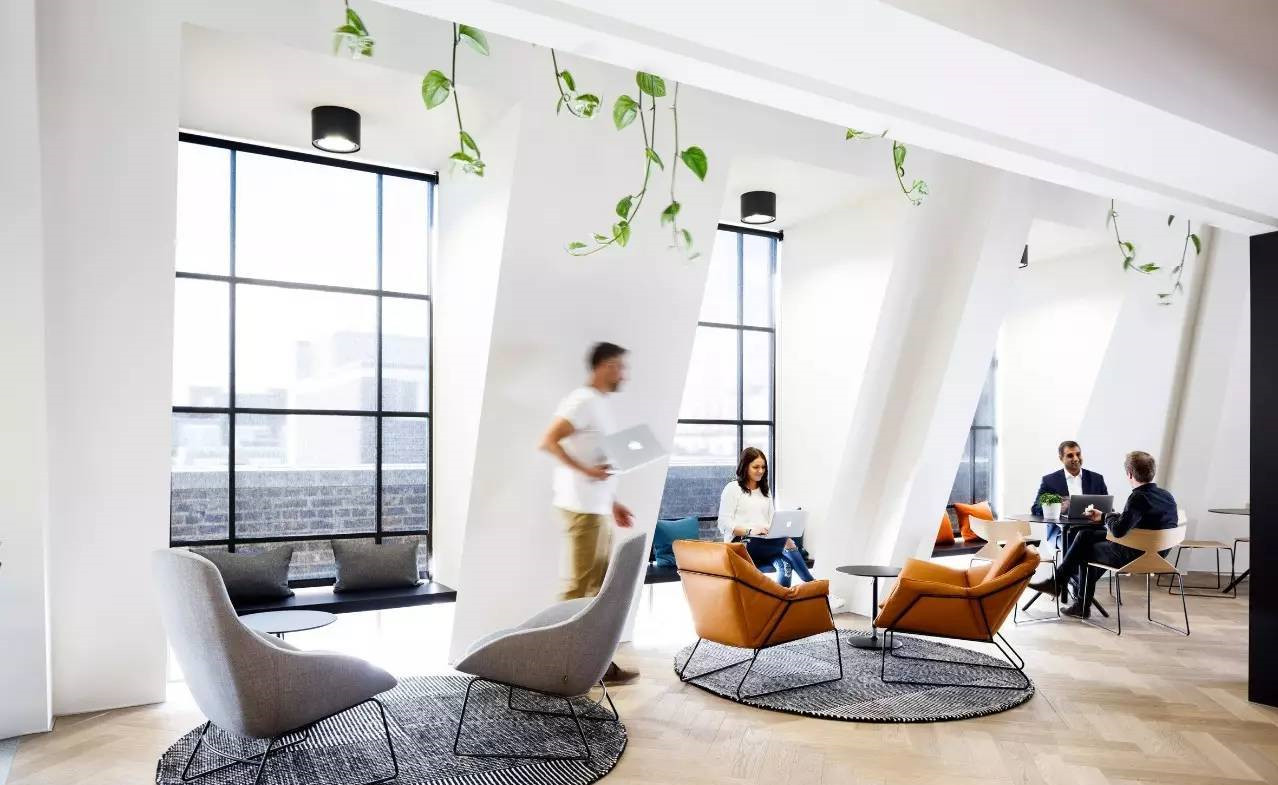
Biological Active Light
Around the beginning of the 21st century, it was discovered that some ganglion cells in the retina are light sensitive with a peak sensitivity around 480 nm (the cyan part of the spectrum). Electric light that activates these cells is known as biological active light or circadian light. This is quantified using the melanopic daylight efficacy ratio (melanopic DER). It is this ratio, coupled with the amount of light that falls into the eye, that measures how well a lighting design supports people’s biorhythms. Light in the morning triggers us to wake up and bright light during the day enhances our circadian rhythm, which regulates our sleepwake cycle, daytime engagement and mood. However, during the night the opposite is true. Deep, more efficient sleep is important for health and wellbeing. In the short term it aids alertness, learning and memory, improves our safety, strengthens restoration, enhances our mood and is part of a healthy lifestyle. In the long term, that helps to develop an active immune system, healthy brain and is good for our cardiometabolic health. Therefore at night, a low activation is required in applications such as hospital patient rooms or 24/7 environments like emergency call centers.
Brighter Office Lighting
So, we know that sufficient light nutrition during the
day makes us less sensitive to late-evening light to
promote sound sleep and an easy wake up. But we
also need light that supports how we see, feel and
function at work. And that requires brighter office
light - high intensity, cyan-enhanced lighting that
falls comfortably into the eye. Because solutions with
biological active light, comfortable brightness and a
high activation during the day offer the most effective
way to create a healthy office environment. That
raises a challenge. Because replicating the 10,000 to
100,000 lux that people experience outdoors is not
realistic, or efficient, in an indoor setting. People also
have a preference for lighting that does not have too
cold a color temperature.
